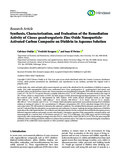Please use this identifier to cite or link to this item:
http://ir-library.mmust.ac.ke:8080/xmlui/handle/123456789/2487| Title: | Synthesis, Characterization, and Evaluation of the Remediation Activity of Cissus quadrangularis Zinc Oxide Nanoparticle-Activated Carbon Composite on Dieldrin in Aqueous Solution |
| Authors: | Ondijo, Calvince Kengara, Fredrick K’Owino, Isaac |
| Keywords: | Synthesis, Characterization, Evaluation,Remediation, Activity, Cissus quadrangularis, Zinc Oxide, Nanoparticle-Activated, Carbon, Composite, Dieldrin,Aqueous, Solution |
| Issue Date: | 21-Apr-2022 |
| Publisher: | Journal of Nanotechnology |
| Abstract: | In this study, zinc oxide-activated carbon nanocomposite was used as the adsorbent for the remediation of dieldrin in aqueous media. Zinc oxide nanoparticles (ZNPs) were synthesized from Cissus quadrangularis (C. quadrangularis) leaf extract, and activated carbon was derived from maize cobs. Nanocomposites were formulated by mixing the ZNPs with the activated carbon in a ratio of 1 : 50. The UV-Vis spectra showed a complete reduction of Zn2+ to Zn0 with plasmon resonance bands in the range of 361–376 nm, which is a characteristic of ZNPs. The SEM images of ZNPs showed hexagonal-shaped particles of 15–20 nm, with face-centered cubic crystals, as demonstrated by XRD analysis. FTIR results showed absorption bands in the ranges 3500–3100 cm−1 (N-H stretch), 3400–2400 cm−1 (O-H stretch), 988–830 cm−1 (C-H bend), 1612 cm−1 (C=C stretch), 400–600 cm−1 (Zn-O stretch), and 1271 cm−1 (C-O bend). Batch adsorption experiments were performed using 20 ml of dieldrin solution at varying pH values (1–14), concentrations (5–100 ppm), temperatures (293–323 K), adsorbent dosages (0.01–0.12 g), and contact times (30–180 minutes) to determine the optimum conditions. The calculated thermodynamic parameters (ΔH°, ΔS°, and ΔG°) indicated that the adsorption was spontaneous and exothermic in nature, implying decreasing randomness of dieldrin molecules at the solid-liquid interface. The isotherm and adsorption kinetics for the composite showed that the absorption process followed Langmuir isotherm and pseudo-second-order kinetics. Adsorption capacities of the nanoparticles, activated carbon, and nanocomposite at a reaction time of 120 minutes and pH of 7 were 3.72 ± 0.068 mg/g, 3.92 ± 0.061 mg/g, and 4.0 ± 0.102 mg/g, respectively, with corresponding percentage removals of 93.12 ± 0.044, 98.04 ± 0.044, and 99.76 ± 0.332. Thus, the nanocomposite exhibited a better sorbing potential for dieldrin in solution than activated carbon. This study recommends testing the remediation potential of the synthesized nanocomposite on other persistent organic pollutants. |
| URI: | https://doi.org/10.1155/2022/2055024 https://www.hindawi.com/journals/jnt/2022/2055024/ http://ir-library.mmust.ac.ke:8080/xmlui/handle/123456789/2487 |
| Appears in Collections: | Gold Collection |
Files in This Item:
| File | Description | Size | Format | |
|---|---|---|---|---|
| Synthesis, Characterization, and Evaluation of the Remediation.pdf | 2.08 MB | Adobe PDF |  View/Open |
Items in DSpace are protected by copyright, with all rights reserved, unless otherwise indicated.
